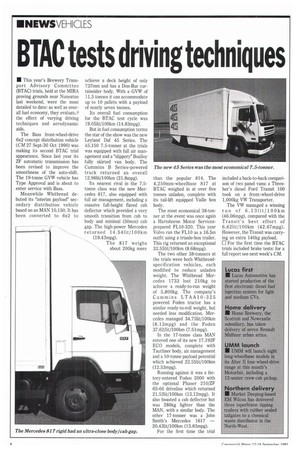BTAC tests driving techniques
Page 10

If you've noticed an error in this article please click here to report it so we can fix it.
• This year's Brewery Transport Advisory Committee (BTAC) trials, held at the MIRA proving grounds near Nuneaton last weekend, were the most detailed to date: as well as overall fuel economy, they evaluated the effect of varying driving techniques and aerodynamic aids.
The Bass front-wheel-drive 6x2 concept distribution vehicle (CM 27 Sept-30 Oct 1990) was making its second BTAC trial appearance. Since last year its ZF automatic transmission has been revised to improve the smoothness of the auto-shift. The 19-tonne GVW vehicle has Type Approval and is about to enter service with Bass.
Meanwhile Whitbread debuted its "interim payload" secondary distribution vehicle based on an MAN 10.150. It has been converted to 6x2 to
achieve a deck height of only 737mm and has a Don-Bur curtainsider body. With a GVW of 11.5 tonnes it can accommodate up to 10 pallets with a payload of nearly seven tonnes.
Its overall fuel consumption for the BTAC test cycle was 19.051it/100Iun (14.83mpg).
But in fuel consumption terms the star of the show was the new Leyland Daf 45 Series. The 46.150 7.5-tonner at the trials was equipped with full air management and a "slippery" Boalloy fully skirted van body. The Cummins B Series-powered truck returned an overall 12.96lit/100km (21.8mpg).
Its nearest rival in the 7.5tonne class was the new Mercedes 817, also equipped with full air management, including a massive full-height flared cab deflector which provided a very smooth transition from cab to body and minimal (50mm) cab gap. The high-power Mercedes returned 14.54Iit/100km (19.43mpg), The 817 weighs about 200kg more than the popular 814. The 4,250mm-wheelbase 817 at BTAC weighed in at over five tonnes unladen, complete with its tail-lift equipped Vaille box body.
The most economical 38-tonner at the event was once again a Hartshorne Motor Servicesprepared FL10-320. This year Volvo ran the FL10 as a 16.5m outfit using a triaxle-box trailer. This rig returned an exceptional 32.551it/100km (8.68mpg).
The two other 38-tonners at the trials were both Whitbreadspecification vehicles, each modified to reduce unladen weight. The Whitbread Mercedes 1733 lost 210kg to achieve a ready-to-run weight of 5,800kg. The company's Cummins LTAA10-325 powered Foden tractor has a similar ready-to-roll weight, but needed less modification. Mercedes managed 34.751k/100km (8.13mpg) and the Foden 37.62/lit/100km (7.51mpg).
In the 17-tonne class MAN entered one of its new 17.192F ECO models, complete with Tautliner body, air management and a 10-tonne payload potential which achieved 22.551it/100ton (12.53mpg).
Running against it was a factory-entered Foden 2000 with the optional Phaser 210/ZF 6S-66 driveline which returned 21.531it/100Iun (13.12mpg). It also boasted a cab deflector but was 280kg lighter than the MAN, with a similar body. The other 17-tonner was a John Smith's Mercedes 1617 — 20.431it/100km (13.83mpg).
For the first time the trial included a back-to-back comparison of two panel vans: a Thresher's diesel Ford Transit 100 took on a front-wheel-drive 1,000kg VW Transporter.
The VW managed a winning run of 6.131it/100km (46.06mpg), compared with the Transit's best effort of 6.621it/100km (42.67mpg). However, the Transit was carrying an extra 140kg payload.
LI For the first time the BTAC trials included brake tests: for a full report see next week's CM.
























































































